Hasegawa 1/32 P-47M Thunderbolt
|
KIT #: |
08181 |
|
PRICE: |
5200 yen at
www.hlj.com
|
|
DECALS: |
Two options |
|
REVIEWER: |
Tom Cleaver |
|
NOTES: |
Special Limited-Edition release |
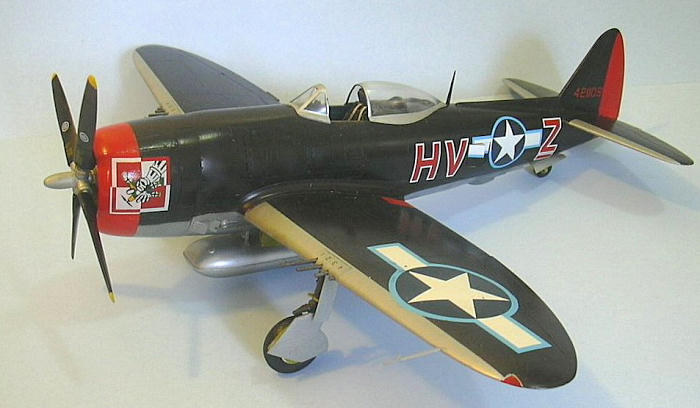
When Col. Don Blakeslee scored the
first victory for the Republic P-47, diving from 23,000 feet on a Fw-190 flying
at 12,000 feet, he was asked about the dive performance of the airplane.
“It certainly ought to dive,” he replied, “since it
can’t climb for a damn.”
This encapsulated the fact that the P-47 - originally
designed as an interceptor - did not in its early stages have the real
performance it needed to be an air superiority fighter.
Changing the propeller from the “toothpick” to the
“Paddle Prop” in early 1944 went a long way to improving the Thunderbolt’s
performance in the vertical plane, but there were other attempts made by
Republic to turn the P-47 into a performer.
By the summer of 1943, it was
obvious that even with the technical fixes Republic was coming up with, the P-47
would always be outperformed by the Focke-Wulf Fw-190 as an air superiority
fighter.
Republic’s answer was to develop the XP-47J during the course of 1943,
utilizing the C-series R-2800-57 engine, which gave 2,800 hp at 2,800 rpm at
35,000 feet in War Emergency Power, which was 133% of rated power. With this
engine, the XP-47J achieved 507 mph at
34,300 feet. At Military Power, the XP-47J hit 470 mph,
and could achieve 435 mph at 81% of rated power - 1,700 hp.
Not only was the airplane faster than just about any
other piston-powered fighter, it had a sea level climb rate of 4,900 fpm, and
did 4,400 fpm at 20,000 feet, an altitude it achieved in 4
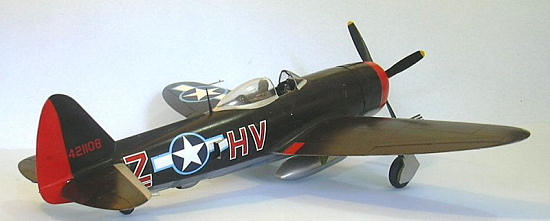 minutes, 15 seconds,
with time to 30,000 feet only 6 minutes, 45 seconds. Not only could it fly and
climb fast,
it had a range of 1,075 miles, which would have made it an
excellent escort fighter.
And all this was achieved with a full 8-gun armament
load. Had the XP-47J been in service when the Me-262 appeared, with its critical
Mach of .83, it could have chased down the German jet with a shallow dive, using
the advantage of its superior service ceiling, which was 46,500 feet.
minutes, 15 seconds,
with time to 30,000 feet only 6 minutes, 45 seconds. Not only could it fly and
climb fast,
it had a range of 1,075 miles, which would have made it an
excellent escort fighter.
And all this was achieved with a full 8-gun armament
load. Had the XP-47J been in service when the Me-262 appeared, with its critical
Mach of .83, it could have chased down the German jet with a shallow dive, using
the advantage of its superior service ceiling, which was 46,500 feet.
Unfortunately, the XP-47J was seen
by the USAAF as little more than a technology demonstrator, since putting it
into production would have involved enough changes to disrupt the output of
Thunderbolts, while the P-51 was seen as being able to provide the range
necessary for escort in the European Theater.
Concurrent with the development of
the XP-47J, Republic stuck a C-series R-2800-57 in a P-47C to see what kind of
extra performance could be achieved while making a minimum of changes to the
basic airframe.
The performance increase was sufficient to lead to further
development of what ultimately became the “hot rod” P-47M.
The need for this performance increase was the
realization that the P-47D did not have a high enough performance lead over the
Fi-103 “buzz bomb” or the new Me-163 and Me-262 fighters whose operational
deployment was expected at any time.
Four P-47D-27-RE airframes were
taken off the Farmingdale production line at Farmingdale and fitted R-2800-57(C)
engine and a larger CH-5 turbosupercharger. The new engine provided WEP of 2800
hp at 32,500 ft using water injection. The aircraft also had
the dive flaps introduced on the P-47D-28.
These four converted P-47Ds were designated as YP-47Ms.
Performance was sufficiently
superior to the P-47D that the new engine and airframe combination was ordered
into production in September 1944.
The last 130 P-47D-30-RE aircraft delivered by
Farmingdale were fitted with the different engine and redesignated P-47M-1-RE.
Performance included a 400 mph maximum speed at 10,000 feet, 453 mph at 25,000
feet, and 470 mph at 30,000 feet. The initial climb rate was 3,500 fpm at 5000
feet and 2,650 feet per minute at 20,000 feet, while range without drop tanks
was 560 miles at 10,000 feet.
This was nowhere close to the XP-47J but it was vastly
superior to the P-47D series.
The first P-47Ms, delivered in
December, 1944, were rushed to the 56th Fighter Group, the last Eighth Air Force
fighter unit equipped with the P-47. The P-47Ms began arriving on January 3,
1945.
The 61st Fighter Squadron
quickly converted to the new Thunderbolt, and immediatel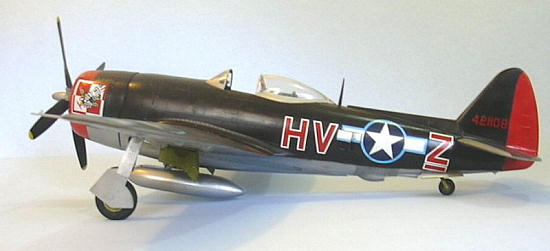 y began to experience
the same kind of engine problems they had confronted with the P-47C in January
1943.
Three crashes due to engine failure, one fatal, led to the P-47M being
grounded in late February, putting the 56th
out of business.
Dave Schilling’s extended tour as Group CO ended on January 27,
and new CO Colonel Lucian Dade - who had been one of the original pilots in the
56th and who had served as squadron
commander, operations officer, and deputy group commander - had to deal with the
engine problems. When war-weary P-51Bs arrived for conversion training, Dade was
able to stave off the dread Mustang when the engineers discovered the engines
had been incorrectly “pickled” for overseas delivery, and the electrical
harnesses had been corroded by exposure to salt air.
With each engine completely overhauled by March 24,
1945, the engine problems were over and the group as a whole was ready to
re-commence operations. P-47Ms were not fitted with underwing racks, since they
were strictly fighters.
y began to experience
the same kind of engine problems they had confronted with the P-47C in January
1943.
Three crashes due to engine failure, one fatal, led to the P-47M being
grounded in late February, putting the 56th
out of business.
Dave Schilling’s extended tour as Group CO ended on January 27,
and new CO Colonel Lucian Dade - who had been one of the original pilots in the
56th and who had served as squadron
commander, operations officer, and deputy group commander - had to deal with the
engine problems. When war-weary P-51Bs arrived for conversion training, Dade was
able to stave off the dread Mustang when the engineers discovered the engines
had been incorrectly “pickled” for overseas delivery, and the electrical
harnesses had been corroded by exposure to salt air.
With each engine completely overhauled by March 24,
1945, the engine problems were over and the group as a whole was ready to
re-commence operations. P-47Ms were not fitted with underwing racks, since they
were strictly fighters.
With only a few weeks of war left,
the 56th demonstrated that the
P-47M was indeed a “hot rod” that turned the Thunderbolt into an air superiority
fighter. The unit was chosen to test the new T-48 incendiary round, designed to
explode the low grade/high flash point fuels the Germans were using, which
resisted ignition by .50-caliber strikes. In April, the 56th flew a series of
airfield strafing attacks using the T-48 round, ending with Dade leading 49
P-47Ms to Eggebek airdrome on April 13, 1945, where they found 150 to 200
aircraft parked on the main field and two nearby satellite strips.
With the 62nd Fighter Squadron flying top cover at
15,000 feet and the
61st Fighter Squadron orbiting at 10,000 feet, the 63rd
Fighter Squadron made the attack.
After a pass to
suppress ground fire, the squadron made 140 individual
passes, claiming 44 destroyed. This was followed by the 61st who made 94 passes
and claimed 25 destroyed, with the 62nd
then making 105 and claiming 26. One P-47M 44-21134 of the 63rd
FS, UN-P, Teacher's Pet, flown by 1st
Lt. William R. Hoffman, was shot down with Hoffman killed when his parachute
failed to open. The mission total was 339 passes, 95 aircraft destroyed, 95
damaged, and more than 78,000 rounds of ammunition expended. Top scorer was 2nd
Lt. Randall Murphy of the 63rd FS, who was credited following review of his gun
camera film with 10 destroyed.
Another strafing mission on April 16, saw the group’s
final combat loss when Capt. John W. Appel of the 62nd
FS was shot down, though he successfully returned to Allied lines the next day.
On April 21st
the group flew its final combat mission.
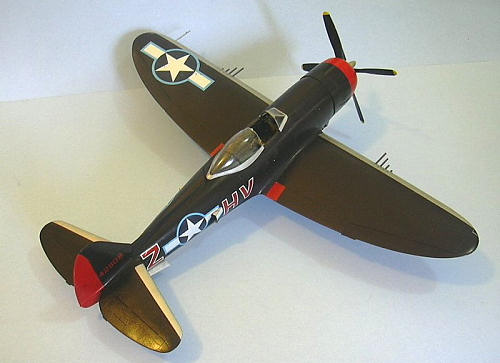 The group’s final aerial victory
was an Me-262 of JG 7 shot down April 10, 1945 by 2nd Lt. Walter J. Sharbo of
the 62nd FS, near Wittstock,
Germany.
Five other jet kills were made with P-47Ms.
Maj. George Bostwick and 2nd Lt. Edwin M. Crosthwait -
also of the 63rd FS - shot down an
Me-262 on March 25, 1945, over Parchim, while Capt. William F. Wilkerson of the
62nd
FS, shot down another Me-262 on April 10, moments before
Sharbo’s final score.
Additionally, two Ar-234 jet bombers were shot down on
March 14, 1945 by pilots of the 62nd
FS - one by 1st Lt. Norman D. Gould and the other shared by 1st Lt. Sandford N.
Ball and 1st Lt. Warren S. Lear. Mike Gladych also claimed an Me-262, though it
was not officially credited to the 56th.
The group’s final aerial victory
was an Me-262 of JG 7 shot down April 10, 1945 by 2nd Lt. Walter J. Sharbo of
the 62nd FS, near Wittstock,
Germany.
Five other jet kills were made with P-47Ms.
Maj. George Bostwick and 2nd Lt. Edwin M. Crosthwait -
also of the 63rd FS - shot down an
Me-262 on March 25, 1945, over Parchim, while Capt. William F. Wilkerson of the
62nd
FS, shot down another Me-262 on April 10, moments before
Sharbo’s final score.
Additionally, two Ar-234 jet bombers were shot down on
March 14, 1945 by pilots of the 62nd
FS - one by 1st Lt. Norman D. Gould and the other shared by 1st Lt. Sandford N.
Ball and 1st Lt. Warren S. Lear. Mike Gladych also claimed an Me-262, though it
was not officially credited to the 56th.
The 56th Fighter Group was credited
by the Eighth Air Force with 674˝ claims for German aircraft destroyed in
air-to-air combat. U.S. Air Force Historical Study No. 85
gave 665.5 aerial victories to the unit, second in the ETO behind the 354th
Pioneer Mustang Group with 701, and
the highest aerial score among all Eighth Air Force
groups.
This is also the highest score of all P-47 groups of the USAAF in all
theaters.
The 61st Fighter Squadron was the top-scoring squadron with 232
shot down by 68 pilots. The 62nd Fighter Squadron was credited with 219.5 kills
by 79 pilots, the 63rd Fighter Squadron with 174.25 kills by 64 pilots, and
group headquarters with 39.75 kills by 4 pilots.
Witold Lanowski:
Witold Lanowski was born
in 1915 in the city of Lwow. In 1935 he joined the Cadet Military Aviation
School in Deblin. After graduation, he became a flying instructor.
Lanowski flew one operational
sortie during the German invasion, in defense of the Deblin airbase. Hoping to
avoid capture, the cadets, instructors, and mechanics evacuated to southern
Poland. Just before crossing the Romanian border on September 17, they were
captured by Soviet cavalry. Lanowski and a few escaped from the column of POW's
and on September 27 they arrived in Romania. A month later, Lanowski headed for
France, where new Polish units were being organized.
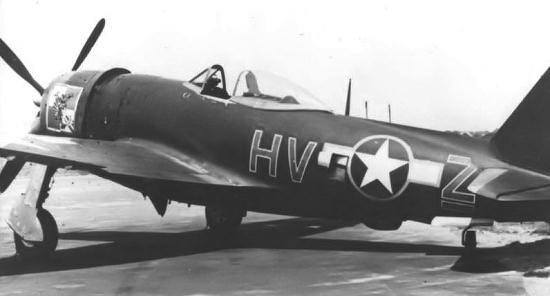 Unfortunately, Lanowski dared to
criticize the French military command and was imprisoned in May of 1940. He
escaped again and landed in Great Britain in July 1940, where he was assigned to
retrain on British planes in April 1941. That November he was posted to 308
Polish Fighter Squadron, "City of Krakow". In January 1941, he moved to 317
Fighter Squadron, "City of Wilno." In December 1942 he arrived in 302 "City of
Poznan" Squadron, assigned as leader of Flight A.
Unfortunately, Lanowski dared to
criticize the French military command and was imprisoned in May of 1940. He
escaped again and landed in Great Britain in July 1940, where he was assigned to
retrain on British planes in April 1941. That November he was posted to 308
Polish Fighter Squadron, "City of Krakow". In January 1941, he moved to 317
Fighter Squadron, "City of Wilno." In December 1942 he arrived in 302 "City of
Poznan" Squadron, assigned as leader of Flight A.
After being grounded for
criticizing the Polish government-in-exile, Lanowski managed to get an
assignment to the 353rd Fighter
Squadron of the 354th Fighter
Group, where he flew P-51 Mustangs and got the nickname “Lanny.”
After learning that Boleslaw “Mike” Gladych and Stefan
Laszkiwicz had found a new home with the 61st
Fighte4r Squadron of the 56th
Fighter Group, Lanowski wangled a transfer.
After 98 scoreless missions with the Polish Air Force,
he scored 4 victories during 1944 with the 56th
FG. Lanowski flew mission 179, his of World War II, on April 19, 1945.
After returning to Poland and
discovering the fate that awaited Poles who had fought in the West, Lanowski
once again escaped his homeland and returned to England, where he rejoined the
RAF, in which he served until 1957.
In 1962, Lanowski joined his
wartime comrade Jan Zumbach in
a mercenary unit Zumbach had organized to fight
for the breakaway province of Katanga in the Congolese Civil War.
Flying for Katanga until Katangese
Air Force was destroyed in 1964, he returned to England
via Angola. Lanowski never received any payment for his combat in Africa. As of
2007, he resides in Essex, Great Britain.
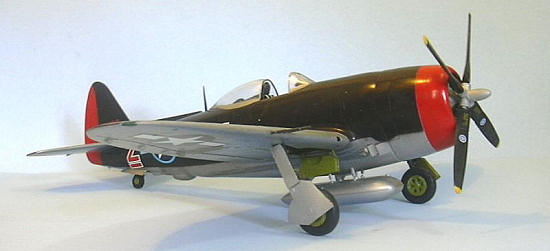 Essentially, this release of the
bubbletop P-47 follows Hasegawa’s long-time strategy of re-releases of major
kits with different decals, detail parts and such.
The kit originally included the Hamilton-Standard prop
associated with the P-47D-25, the Curtiss-Electric “paddle-prop” used by the
P-47D-27 onwards, and a late paddle prop most people assume was used by the
P-47M.
Interestingly, I have yet to find a photo of a 56th
FG P-47M that used this prop, all of them being equipped with the earlier
“paddle prop.”
This is good news, given that the “P-47M prop” is very
anemic-looking, while the earlier prop looks excellent.
The kit includes very good decals for Witold Lanowski’s
distinctively-marked P-47M, and a natural metal P-47M that was seen parked
beneath the Eiffel Tower in the Victory celebration
in the summer of 1945.
Essentially, this release of the
bubbletop P-47 follows Hasegawa’s long-time strategy of re-releases of major
kits with different decals, detail parts and such.
The kit originally included the Hamilton-Standard prop
associated with the P-47D-25, the Curtiss-Electric “paddle-prop” used by the
P-47D-27 onwards, and a late paddle prop most people assume was used by the
P-47M.
Interestingly, I have yet to find a photo of a 56th
FG P-47M that used this prop, all of them being equipped with the earlier
“paddle prop.”
This is good news, given that the “P-47M prop” is very
anemic-looking, while the earlier prop looks excellent.
The kit includes very good decals for Witold Lanowski’s
distinctively-marked P-47M, and a natural metal P-47M that was seen parked
beneath the Eiffel Tower in the Victory celebration
in the summer of 1945.
Construction was a carbon copy of
what I experienced with the first Hasegawa bubbletop kit, other than I used the
extended fin which the kit provided, and assembled the flaps in the up position
as an exercise to see if they could be put in that position successfully.
Some flaps-down kits really can’t be done with the flaps
up (think the Tamiya P-51D and F4U series) without extra
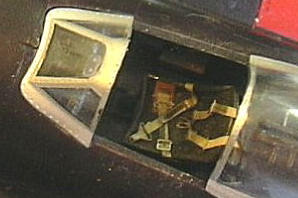 effort.
These flaps were as easy to assemble in the up position
as were the flaps on the Trumpeter kit.
One also uses different lower wing inserts that include
the dive flaps and the landing light in the outboard position.
effort.
These flaps were as easy to assemble in the up position
as were the flaps on the Trumpeter kit.
One also uses different lower wing inserts that include
the dive flaps and the landing light in the outboard position.
I had experienced difficulty
fitting the engine and cowling to the first kit, which resulted in a “step” on
the lower profile that required me to use quite a bit of Mr. Surfacer 500 to
solve.
I solved this problem this time by raising the upper line of the opening
for the flap plate, so that the assembled engine and cowling sat correctly
without any step.
This fix was considerably easier than using all the
putty, and is commended to all modelers as the “fix” that works for this kit.
This kit provides the correct
magnetos and engine front for the later R-2800-57(C).
I used the Eduard 1/32 P-47 Cockpit
interior, which includes instrument panels, a map case cover, and other small
details as well as photoetch seat belts.
These really make the kit-supplied cockpit look good.
Painting:
I was very glad to make use of the
article over at HyperScale that shows a model made for Mike Gladych by his crew
chief, using the original paint used on the upper surfaces of this airplane.
The 61st
Fighter Squadron is supposed to have had the upper surfaces painted black, though
research has shown these airplanes all differed, with color ranging from a
super-dark cobalt blue to a purplis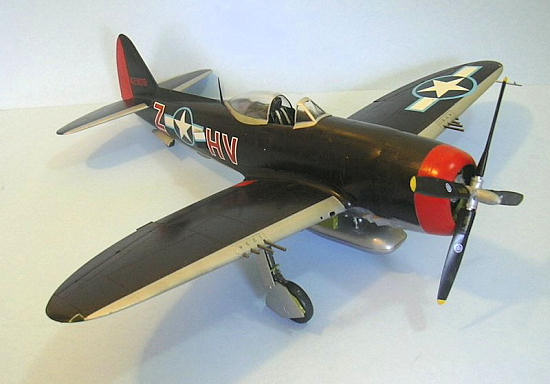 h tone.
I went with the dark purplish color, which I created by
mixing Gunze-Sangyo “Wine Red” with “Gloss Black” till I achieved the desired
shade.
I don’t know how well this color will come across in photos on the net,
but in person it is indeed the “very dark plum” color described in that article.
h tone.
I went with the dark purplish color, which I created by
mixing Gunze-Sangyo “Wine Red” with “Gloss Black” till I achieved the desired
shade.
I don’t know how well this color will come across in photos on the net,
but in person it is indeed the “very dark plum” color described in that article.
The natural metal surfaces were
painted with Talon acrylic Aluminum, with their dark metal color used for
different panels.
This paint works fine if you do not polish the plastic
surface a lot.
If you do, the paint can “bead” when airbrushed.
If you do polish the model, it is best to apply a light
grey primer before using the Talon paint, which then goes down nice and smooth.
This paint has the added plus that you won’t have to
haul out the industrial orange extension cord to take the air brush outside to
apply the metalizer paint, which is what I have to do when I use lacquer-base
metalizer paints.
The Talon paint had no problem being masked with both
Tamiya tape and regular drafting tape, after it had been left to dry thoroughly
for 24 hours.
The red nose and rudder were
painted with Gunze “Red Madder,” which was then masked off before the “dark
plum” was applied.
Decals:
The kit decals went down without
problem.
The new Hasegawa decals have finally solved the problem of the “ivory”
white.
Now that I have built three
Hasegawa P-47s and two from Trumpeter, I have to say that the Trumpeter kit has
the better production design as far as problem-free assembly is concerned.
I don’t know how Hasegawa managed to screw up the
attachment of the engine and cowling to the fuselage, but it shouldn’t have
happened, and has caused much head-scratching among modelers.
The Trumpeter detail parts are also superior.
The Hasegawa bubble canopy is closer to the correct
shape than the Trumpeter, but this is really only obvious if you study photos
for awhile. While I do like the lack of rivet divots on the Hasegawa kit, it is
only on that issue and price that the Hasegawa kit is in any way superior to the
Trumpeter kit.
That said, the Hasegawa kit obviously makes up into a nice model,
and is highly recommended.
Tom Cleaver
August 2008
Review kit courtesy of HobbyLink Japan.
Get yours at www.hlj.com
If you would like your product reviewed fairly and quickly, please
contact
me or see other details in the
Note to
Contributors.
Back to the Main Page
Back to the Review
Index Page


 minutes, 15 seconds,
with time to 30,000 feet only 6 minutes, 45 seconds. Not only could it fly and
climb fast,
it had a range of 1,075 miles, which would have made it an
excellent escort fighter.
And all this was achieved with a full 8-gun armament
load. Had the XP-47J been in service when the Me-262 appeared, with its critical
Mach of .83, it could have chased down the German jet with a shallow dive, using
the advantage of its superior service ceiling, which was 46,500 feet.
minutes, 15 seconds,
with time to 30,000 feet only 6 minutes, 45 seconds. Not only could it fly and
climb fast,
it had a range of 1,075 miles, which would have made it an
excellent escort fighter.
And all this was achieved with a full 8-gun armament
load. Had the XP-47J been in service when the Me-262 appeared, with its critical
Mach of .83, it could have chased down the German jet with a shallow dive, using
the advantage of its superior service ceiling, which was 46,500 feet. y began to experience
the same kind of engine problems they had confronted with the P-47C in January
1943.
Three crashes due to engine failure, one fatal, led to the P-47M being
grounded in late February, putting the 56th
out of business.
Dave Schilling’s extended tour as Group CO ended on January 27,
and new CO Colonel Lucian Dade - who had been one of the original pilots in the
56th and who had served as squadron
commander, operations officer, and deputy group commander - had to deal with the
engine problems. When war-weary P-51Bs arrived for conversion training, Dade was
able to stave off the dread Mustang when the engineers discovered the engines
had been incorrectly “pickled” for overseas delivery, and the electrical
harnesses had been corroded by exposure to salt air.
With each engine completely overhauled by March 24,
1945, the engine problems were over and the group as a whole was ready to
re-commence operations. P-47Ms were not fitted with underwing racks, since they
were strictly fighters.
y began to experience
the same kind of engine problems they had confronted with the P-47C in January
1943.
Three crashes due to engine failure, one fatal, led to the P-47M being
grounded in late February, putting the 56th
out of business.
Dave Schilling’s extended tour as Group CO ended on January 27,
and new CO Colonel Lucian Dade - who had been one of the original pilots in the
56th and who had served as squadron
commander, operations officer, and deputy group commander - had to deal with the
engine problems. When war-weary P-51Bs arrived for conversion training, Dade was
able to stave off the dread Mustang when the engineers discovered the engines
had been incorrectly “pickled” for overseas delivery, and the electrical
harnesses had been corroded by exposure to salt air.
With each engine completely overhauled by March 24,
1945, the engine problems were over and the group as a whole was ready to
re-commence operations. P-47Ms were not fitted with underwing racks, since they
were strictly fighters. 
 Unfortunately, Lanowski dared to
criticize the French military command and was imprisoned in May of 1940. He
escaped again and landed in Great Britain in July 1940, where he was assigned to
retrain on British planes in April 1941. That November he was posted to 308
Polish Fighter Squadron, "City of Krakow". In January 1941, he moved to 317
Fighter Squadron, "City of Wilno." In December 1942 he arrived in 302 "City of
Poznan" Squadron, assigned as leader of Flight A.
Unfortunately, Lanowski dared to
criticize the French military command and was imprisoned in May of 1940. He
escaped again and landed in Great Britain in July 1940, where he was assigned to
retrain on British planes in April 1941. That November he was posted to 308
Polish Fighter Squadron, "City of Krakow". In January 1941, he moved to 317
Fighter Squadron, "City of Wilno." In December 1942 he arrived in 302 "City of
Poznan" Squadron, assigned as leader of Flight A.
 effort.
These flaps were as easy to assemble in the up position
as were the flaps on the Trumpeter kit.
One also uses different lower wing inserts that include
the dive flaps and the landing light in the outboard position.
effort.
These flaps were as easy to assemble in the up position
as were the flaps on the Trumpeter kit.
One also uses different lower wing inserts that include
the dive flaps and the landing light in the outboard position.